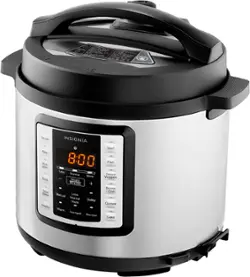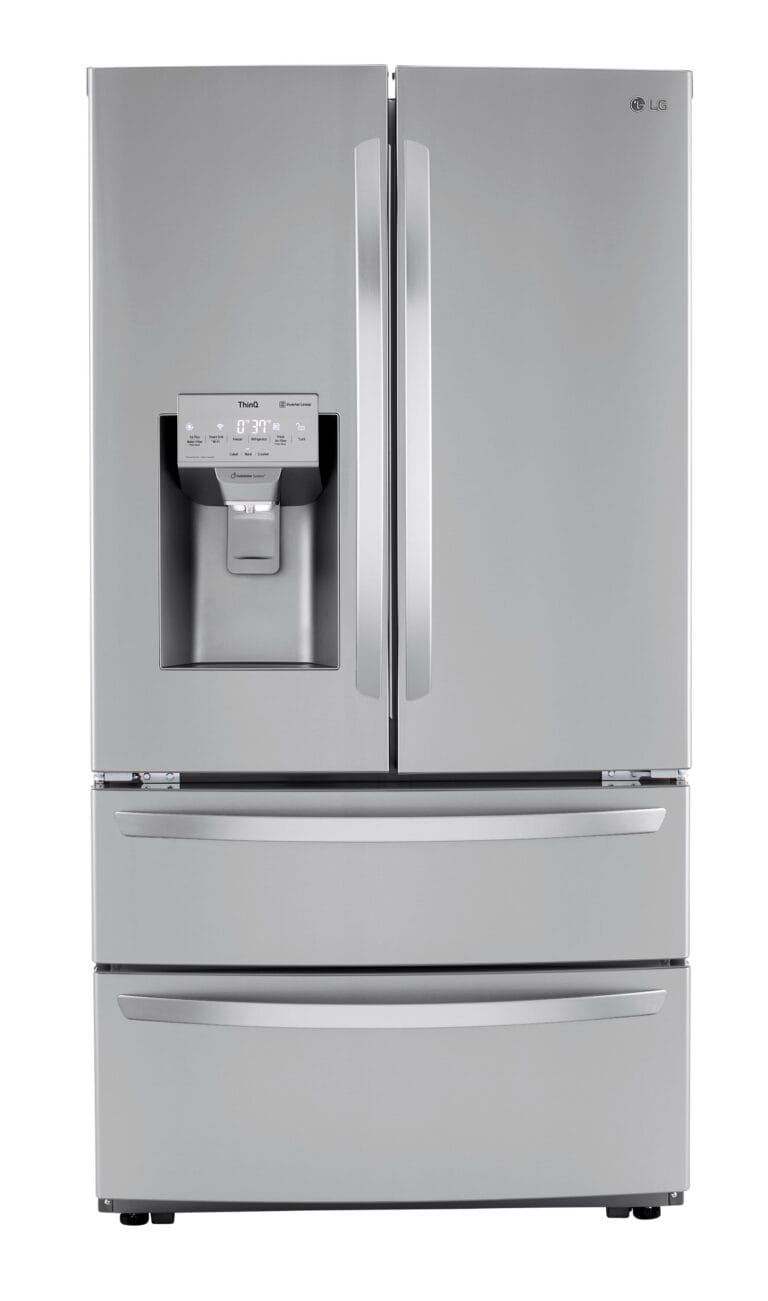
Insignia Instant Pot troubleshooting can save you time and frustration when your appliance acts up. These electric pressure cookers may encounter issues like not sealing properly, failing to build pressure, or displaying error codes. By understanding common problems and their fixes, you can often get your Instant Pot working again without calling customer service.
Many Instant Pot problems have simple solutions. For instance, if steam escapes from the sides of the lid, you might need to clean or reposition the valve. When the pot won’t build pressure, check that the steam release is set to “Sealing” and not “Venting”. Error codes often point to specific issues, like overheating or faulty sensors.
Safety is key when troubleshooting your Instant Pot. Always unplug the unit and let it cool before inspecting internal parts. If you’re unsure about a repair, consult the user manual or contact Insignia support for guidance. With proper care and quick fixes, your Instant Pot can continue to make meals easier for years to come.
| Common Issue | Quick Fix |
|---|---|
| Not sealing | Check lid positioning |
| No pressure | Ensure valve is set to “Sealing” |
| Error codes | Refer to manual for specific solutions |
| Food burning | Add more liquid to recipe |
✅ 1. Cooker Won’t Turn On
Possible Causes:
- Power cord not connected properly.
- Outlet not working.
- Internal fuse issue.
Fix:
- Make sure the power cord is firmly plugged in to both the cooker and the wall outlet.
- Test the outlet with another device.
- If still unresponsive, unplug and let it cool for 30 minutes. If the problem persists, contact Insignia support.
✅ 2. Lid Won’t Close or Lock
Possible Causes:
- Sealing ring misaligned.
- Food debris stuck in the lid track.
Fix:
- Remove the silicone sealing ring, clean it, and reinstall it evenly.
- Wipe the lid track and locking pin area.
- Align the lid arrows with the cooker base before turning to lock.
✅ 3. Steam Leaking Around Lid
Possible Causes:
- Sealing ring not seated properly.
- Sealing ring worn out or stretched.
- Float valve not sealing.
Fix:
- Reseat the sealing ring securely.
- Replace the sealing ring if it’s cracked or loose (recommended every 12–18 months).
- Clean the float valve and ensure it moves freely.
✅ 4. “Food Burn” or “OvHt” Message
Possible Causes:
- Not enough liquid in the pot.
- Food stuck to the bottom.
- Thick sauces triggering overheating.
Fix:
- Always use at least 1 cup of liquid when pressure cooking.
- Deglaze the pot by scraping the bottom with a wooden spoon after sautéing.
- Avoid using thick sauces as the main cooking liquid—add water or broth.
✅ 5. Pressure Not Building
Possible Causes:
- Lid not sealed.
- Steam release valve set to “Venting” instead of “Sealing.”
- Too little liquid inside.
Fix:
- Check sealing ring and float valve.
- Turn the steam release handle to Sealing.
- Add more liquid if needed.
✅ 6. Error Codes (Common Ones)
- E1/E2: Sensor malfunction → unplug, let cool, restart. If it persists, contact support.
- E3: Overheating → check for burnt food, add more liquid.
- E4: Pressure sensor issue → unplug and reset.
- E5: Lid not detected → check lid position and locking mechanism.
(source: Insignia Troubleshooting Guide, Manualslib – NS-MC60SS9 Manual)
✅ 7. Strange Smells After Cooking
Fix:
- Remove and wash the sealing ring (it absorbs odors easily).
- Soak the ring in vinegar + baking soda solution.
- Consider keeping two rings: one for savory dishes, one for desserts.
⚠️ Safety Tips
- Never force the lid open—wait until the float valve drops.
- Do not fill above the MAX line (especially with beans, rice, or foamy foods).
- Replace sealing rings regularly for safe operation.
📞 Need More Help?
- Insignia Support: Best Buy Support Page
- Manuals: Insignia NS-MC60SS9 User Manual
Understanding Your Instant Pot
The Instant Pot is a versatile kitchen appliance with various components and safety features. Familiarizing yourself with these elements will help you use your Instant Pot effectively and safely.
Components and Functions
The Instant Pot Duo consists of several key parts. The inner pot is where you place ingredients for cooking. A removable lid seals the unit during pressure cooking. The control panel lets you select cooking programs and adjust settings.
The heating element sits at the base of the unit. It heats the contents and generates steam for pressure cooking. A pressure valve regulates the internal pressure during cooking.
The float valve is a metal pin that rises when pressure builds inside. This locks the lid in place for safety. A silicone sealing ring creates an airtight seal between the lid and pot.
The steam release valve allows you to release pressure manually when cooking is complete. Some models have an automatic pressure release function.
Safety Features and Mechanisms
Instant Pots have multiple safety mechanisms to prevent accidents. The lid-locking pin prevents opening while under pressure. A pressure sensor monitors internal pressure and adjusts heat as needed.
If the float valve gets stuck, you can gently push it down with a utensil. Clean it regularly to prevent sticking. The anti-block shield stops food particles from clogging the steam release valve.
A thermal fuse cuts power if the pot overheats. The pressure release button lets you safely vent steam. Always use caution when releasing pressure to avoid burns.
| Safety Feature | Function |
|---|---|
| Lid-locking pin | Prevents opening under pressure |
| Pressure sensor | Monitors and regulates pressure |
| Anti-block shield | Protects steam release valve |
| Thermal fuse | Cuts power if overheating occurs |
Regular maintenance of these safety features ensures your Instant Pot operates properly. Check the sealing ring for damage and replace it if needed. Clean valves and sensors after each use.
Common Issues and Solutions
Instant Pot users often face several challenges. Knowing how to address error codes, sealing problems, and heating issues can help you get the most out of your appliance.
Error Codes and Interpretations
Error codes on your Instant Pot can be confusing. The “C6” code often indicates a faulty pressure sensor. To fix this, unplug your pot and check the sensor connections.
“Burn” messages usually mean food is stuck to the bottom. Clean the inner pot thoroughly and add more liquid to your recipe.
If you see “noPr,” your pot isn’t building pressure. Check the sealing ring and steam release valve.
Here’s a quick reference table for common error codes:
| Error Code | Meaning | Solution |
|---|---|---|
| C6 | Faulty pressure sensor | Check connections |
| Burn | Food sticking | Clean pot, add liquid |
| noPr | No pressure | Check sealing ring |
Sealing and Pressure Problems
Steam leaks are a common issue. If steam escapes from the sides, your sealing ring may be damaged or improperly installed. Remove and reinsert the ring, ensuring it’s clean and undamaged.
Check that the steam release valve is in the “Sealing” position before cooking. A misaligned valve can prevent pressure buildup.
If your pot won’t pressurize, food particles might be blocking the float valve. Clean it gently with a pin or soft brush.
Make sure you’re using enough liquid. Most recipes need at least 1 cup of liquid to create steam and build pressure.
Heating and Power Complications
If your Instant Pot isn’t heating, first check that it’s plugged in properly. A loose connection can cause power issues.
The heating element may be faulty if the pot doesn’t get hot. In this case, you’ll need to contact customer support for repairs or replacement.
Sometimes, the lid won’t close properly. Check the float valve for obstructions. It should move freely up and down.
If you smell burning plastic, unplug your pot immediately. This could indicate an electrical problem that requires professional attention.
Maintenance and Care
Proper maintenance of your Insignia Instant Pot ensures its longevity and optimal performance. Regular cleaning and timely replacement of parts are crucial for safe operation and delicious meals.
Regular Cleaning and Gasket Replacement
Clean your Instant Pot after each use. Wipe the exterior with a damp cloth. Remove and wash the inner pot, lid, and sealing ring with warm soapy water. Dry thoroughly before reassembling.
The sealing ring absorbs food odors over time. Replace it every 12-18 months or sooner if you notice any damage. Keep a spare on hand to avoid delays in cooking.
Clean the pressure release valve regularly. Remove it carefully and rinse under warm water to remove any debris. Ensure it’s completely dry before reattaching.
| Part | Cleaning Frequency | Replacement Interval |
|---|---|---|
| Inner Pot | After each use | As needed |
| Sealing Ring | After each use | Every 12-18 months |
| Pressure Release Valve | Weekly | As needed |
Dealing with Wear and Tear
Inspect your Instant Pot regularly for signs of wear. Check the inner pot for scratches or dents. Replace if damaged to maintain even heat distribution.
Examine the lid for cracks or warping. A damaged lid can compromise pressure sealing. Replace immediately if you notice any issues.
Test the sealing ring’s elasticity periodically. If it feels loose or stretched, it’s time for a replacement. A snug fit is essential for proper pressure buildup.
Keep the pressure release valve clean and functional. If it sticks or doesn’t seal properly, replace it promptly to avoid safety issues.
Store your Instant Pot with the lid upside down to prevent odor buildup and extend the life of the sealing ring.
Optimizing Cooking Performance
Proper timing and pressure release techniques are key to getting the best results from your Insignia Instant Pot. These methods help ensure food is cooked perfectly and safely.
Adjusting Cooking Time and Temperature
Set the right cooking time for each dish. Most Instant Pot recipes provide specific timings. If food comes out undercooked, add 1-2 minutes next time. For overcooked food, reduce the time slightly.
Use the right temperature setting. The “Normal” mode works for most dishes. “Less” is good for delicate foods. “More” helps with tough meats.
Watch for the “burn” warning. This means there’s not enough liquid. Add 1/2 cup of broth or water if you see this message.
| Setting | Best For |
|---|---|
| Less | Vegetables, fish |
| Normal | Rice, beans, chicken |
| More | Tough meats, stews |
Using Quick Release Method
The quick release method helps stop cooking immediately. It’s useful for foods that cook fast like vegetables.
To use quick release:
- Wear oven mitts for safety
- Turn the steam release valve to “Venting”
- Wait for the float valve to drop
Be careful of hot steam. Keep your hands and face away from the valve.
For foamy foods like pasta, use intermittent quick release. Open the valve for 1 second, then close for 5 seconds. Repeat until pressure is gone.
If food sprays out, close the valve and wait 5 minutes before trying again.
Frequently Asked Questions
Insignia Instant Pot users often encounter issues and seek quick solutions. These common questions address key troubleshooting steps and resources to help resolve problems efficiently.
How can I access the Insignia Instant Pot troubleshooting manual?
You can find the Insignia Instant Pot troubleshooting manual on the manufacturer’s website. Look for the “Support” or “Resources” section to download the PDF version. Some retailers also provide digital copies of the manual with your purchase.
What do the error codes on my Insignia Instant Pot mean?
Error codes on your Insignia Instant Pot indicate specific issues. Common codes include:
- C1: Faulty temperature sensor
- C2: Too little liquid in the pot
- C6: Faulty pressure sensor
Consult your manual for a full list of codes and their meanings.
Is there a way to reset my Insignia Instant Pot?
Yes, you can reset your Insignia Instant Pot. Unplug the device for about 5 minutes. Then plug it back in and test its functions. This often resolves minor electronic glitches.
What should I do if my Instant Pot’s pressure cook function is not working?
If the pressure cook function fails, check these items:
- Ensure the lid is properly sealed
- Verify the steam release valve is in the “Sealing” position
- Add enough liquid (at least 1 cup) to create pressure
If problems persist, inspect the sealing ring for damage.
How can I fix an Instant Pot that is not coming to pressure?
When your Instant Pot struggles to pressurize:
- Check the sealing ring for proper placement
- Clean the anti-block shield
- Ensure enough liquid is in the pot
- Verify the steam release valve is closed
These steps often resolve pressurization issues.
Where can I find professional repair services for an Instant Pot?
For professional repairs:
- Contact Insignia customer support for authorized service centers
- Check with local appliance repair shops that handle small kitchen appliances
- Some electronics stores offer repair services for kitchen gadgets
Always use certified technicians to maintain your warranty and ensure safe repairs.






